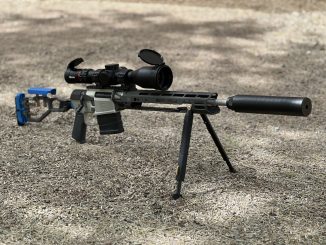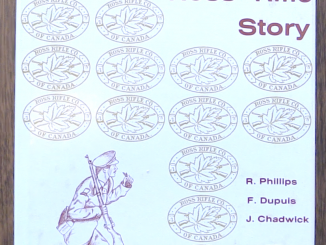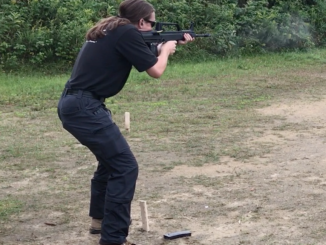The standard Canadian sniper’s rifle of World War One was the MkIII Ross fitted with a Warner & Swasey “musket sight” purchased from the United States. However, armorers in the field did create sniping rifles using other scopes – in particular the Winchester A5. The A5 was a popular commercial rifle scope at the time, and it found its way onto military rifles for many nations – I have seen examples on Lebel and SMLE rifles as well as of course American Springfields and this Ross.
The A5 was a 5x magnification scope with external adjustments. We don’t know when this example was built into sniper configuration, but it’s provenance is solid (this sort of thing would be relatively easy to counterfeit). Personally, I would much prefer a Winchester A5 over the Warner & Swasey pattern…




Someday I would love to see a treatment of the development of optical sights. It is amazing how precision manufacturing, materials science, and the understanding of optical principles all came together to take us from unsealed scopes the length of the barrel with external adjustments to modern 1-10x scopes that fit on an AR.
“(…)from unsealed scopes the length of the barrel with external adjustments to modern 1-10x scopes that fit on an AR.”
Ah yes, Whitworth Rifle (scoped) https://www.militaryfactory.com/smallarms/detail.php?smallarms_id=525
Anyway if such big sight is encumbrance for you, there were tubeless sights used by British during Great War, it was dubbed “Galilean” https://www.americanrifleman.org/content/wwi-galilean-sights-an-evolution-in-sniping/
Interestingly designation of Soviet ПУ (used since 1940) stands for Прицел Укороченный i.e. Sight Shortened. By 1948 United Kingdom managed to developed scope which was integrated with selective-fire rifle known as BSA 28P see 1st photo from top https://guns.fandom.com/wiki/BSA_28P in apparently not-cumbersome way.
Me too. It has been a tremendous progress since what we see in this video over first generation 4×21 Hakko scopes applied on M16 rifles to what is available to militaries today. Perhaps some optical geek would like to volunteer?
It’s not just quality of scopes, but price relative to the rifle that has improved. The October 1922 issue of Field and Stream lists a Hensoldt 4x scope (with mount) for 45 dollars, and just the mount was $23. The Sears catalog for the same year puts a Winchester 1894 (hardly a cheap gun) at $29.70. Even war surplus Winchester Model Bs went for $15 (+5.95 for the mount) in W.Stokes Kirk, Catalogue No.24-B (1920).
Herbert McBride in his memoirs did praise the Ross, but he preferred the much-maligned Warner & Swasey sights because they were offset — he preferred to have the iron sights available to him. Of course he was such a superb marksman he frequently didn’t need magnification. The book is entitled “A Rifleman Goes to War.”
I suspect that there’s a lot of information that has been lost
And that there was a very large “knowledge problem” for the hierarchical military structure (by its very definition, hierarchy must result in knowledge problems).
Knowledge of mounting high quality scopes into quick detachable mounts, was distributed around the gun trades on all three sides in WW1
Relatively little of that distributed knowledge seems to have been picked up by the hierarchy.
It would be interesting to look at the social history of why some scopes and mounting systems gained military prominence, and why others didn’t.
I know that in aircraft engines and early tank engines, the info that was used, reached the hierarchy through the members of the London gentlemens clubs that they ate and drank in.
I don’t know whether the choices of scopes and scope mounting systems, and who got the contract to fit them, depended on which gun maker the senior officer was a pre war customer of, or who was a member of the same Gentleman’s club
Accepting that the Warner and Swasey, was not a particularly good scope, even for its time…
Prismatic scopes, did, and still would, allow a low cheek weld, without having to remove iron sights.
Good prismatic sights and quick mounts, that retained zero, were available pre ww1.
Unfortunately, Britain, France, Italy, Russia, Serbia… went to war with the states where good scopes were made.
Link shows a Ziess prismatic scope in quick mounts that retain zero
On a double rifle that fires rimless cases
All from 1911
https://www.westleyrichards.com/theexplora/vintage-318-modele-de-luxe/
Thinking about scope mounting…
Continental break open rifles and combination guns, have been made with built in claw mounts, that retain zero, probably since the 1900s
Mannlicher schönauer sporting rifles from Steyr, could be factory fitted with a circular dovetail front mount on the barrel and a rear mount over the receiver, that allowed quick mounting and removal, without losing zero.
Brno’s beautiful ZG47 sporters (designed by Otakar Galaš) Had proper dovetails machined as square bridges on the receiver ring and bridge, along with a cut out in the rear dovetail to work as a recoil stop.
The Brno Fox, and the Krico version of it, both had integral dovetails as well
Similarly, Sako began machining receivers with integral dovetails in the 1940s- 50s. I’m not sure when Tikka started. BSA had integral dovetails in the 1950s
The Ruger 77, is the First American bolt action that I’m aware of that had integral dovetails.
Considering that almost all sporting rifles will be used with scopes…
Why do so many people still buy rifles with only crappy holes drilled and tapped in them.
The hundred year old “Suhler Einhakmontage” is still manufactured to this day. And why not? It does its job and is lightweight.
But I never understood, why it never really was used by any military. Yes it blocks the iron sights, but it is actually quick detachable and a sniper only needs iron sights as a back up anyway.
Drilling and tapping holes into receivers is frowned upon in Germany (and Europe in general) nowadays for safety concerns, because you possibly introduce a weak point by drilling a hole into your gun. Leading to old rifles headed for snmelting, because they have holes drilled into them. I guess why americans buy such guns still is habit (or tradition by now) and that they are cheap bastards. Any other mounts is more complicated and costs more.
Regarding stress around holes
The Kirsch equation, of 1898, was the first equation allowing stresses to be calculated
It describes the stress distribution around a circular hole in an infinite plate.
There are a bunch of assumptions/ caveats in there, for example, it assumes Continuous, homogeneous, isotropic, and linear elasticity…
Within those assumptions, the least effect of a circular hole is to double the stress.
W W Greener, in “The Gun”, said that anyone who takes Americans for fools, is going to get a nasty shock
Until it comes to guns
I can’t remember his exact words following that,
I think he actually underestimated their gullibility and backwardness. He put them at about 15 years behind the British gun makers
With respect to things like rimless magnums based on a .404 Jeffrey case, that will work through a standard length Mauser 98, they were actually more like 60 or 70 years behind
The Same for adoption of Paul Mauser’s ideas about breech design and gas protection
And the very latest developments are not getting into computer-assisted fire control systems, e.g. https://www.army.mil/article/180370/pm_soldier_weapons_developing_first_integrated_fire_control_for_small_arms_weapons
Correction: “… latest developments are NOW getting into …” (not “not getting…”
The A-5 on the Ross is out of “battery”. There is a stop ring near the front of the scope that should be resting against the front scope mount. The scope slides forward during recoil and then must be pushed back towards the butt for the next shot. It looks as though the stop ring is out of adjustment because the rear of the scope would be over the comb in its current configuration. Btw this is how you set the eye relief on this kind of telescope.
Apologies
Completely OT, but unfortunately it’s current.
https://www.zerohedge.com/geopolitical/biden-administration-bans-russian-made-ammo-amid-shortage
Like all “protectionist” and “sanctions” measures, it’s at its most aggressionist against consumers.
Stupidity at its finest. Would Russia even bother exporting ammunition to America now?
The last 5 years have been a protectionist’s wet dream and we have nothing but the highest steel prices in the world to show for it.
“Completely OT, but unfortunately it’s current.”(С)
Small loss.
Their ammunition was of interest as long as it was a warehouse surplus of military ammunition. At a low price and not the lousy quality.
It all ended long ago.
And let them eat the rubbish that they are doing now alone.
The ammuniton supplied to the military is still the same spam cans as they used to be. Quality is also the same. It was just the export ammo, that was made to the lowest price point possible with the resulting low quality.
This is a replica as the rifle is marked to the 50th Gordon Highlanders of Canada, a Militia regiment who never went overseas in WWI. Nor are there any Canadian Expeditionary Force formation/battalion markings on the butt as there are on Rosses that were in France in WWI. Comparing to original photos from WWI, the scope is not correctly mounted and the barrels on these rifles were cut down rather than the just having the foresight removed as on this one, so it wasn’t “modified in the field” unless it was a field here in Canada LOL. The scope is a bad joke compared to German optics of the time, even compared to some British scopes, but like the Warner & Swasey it’s all that was available. The best part of this setup was that the scope could be pushed forward in the rings to allow the rifle to be clip loaded from a charger. Pulling the scope back into the firing position after every shot must have been a PITA. The post by “Bearded Conservative General” above is correct. The best information these is in Frank Iriam’s memoir “In the Trenches 1914-1918” He was a sniper in the 8th Battalion CEF.